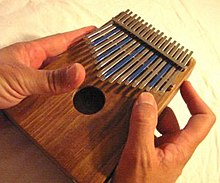
Back Lamel·lòfon Catalan Lamellophon German Lamelófono Spanish سازهای تیغهای Persian Lamelófono Galician Lamellofoni Italian ラメラフォン Japanese Lamellofoon Dutch Lamelofone Portuguese


A lamellophone (also lamellaphone or linguaphone) is a member of the family of musical instruments that makes its sound by a thin vibrating plate called a lamella or tongue, which is fixed at one end and has the other end free. When the musician depresses the free end of a plate with a finger or fingernail, and then allows the finger to slip off, the released plate vibrates. An instrument may have a single tongue (such as a Jew's harp) or a series of multiple tongues (such as a mbira thumb piano).
Linguaphone comes from the Latin root lingua meaning "tongue", (i.e., a long thin plate that is fixed only at one end). lamellophone comes from the Latin word lamella for "small metal plate",[1] and the Greek word φωνή phonē for "sound, voice".[2]
The lamellophones constitute category 12 in the Hornbostel–Sachs system for classifying musical instruments, plucked idiophones. There are two main categories of plucked idiophones, those that are in the form of a frame (121) and those that are in the form of a comb (122).
The most usual [of plucked idiophones] is a flexible lamella or tongue attached to a frame, plucked by a finger and resonated by a small box.
- ^ lamella. Charlton T. Lewis and Charles Short. A Latin Dictionary on Perseus Project.
- ^ φωνή. Liddell, Henry George; Scott, Robert; A Greek–English Lexicon at the Perseus Project.
- ^ Sachs, Curt (1940). The History of Musical Instruments, p.455. W. W. Nortan & Company, Inc. ISBN 0-393-02068-1
© MMXXIII Rich X Search. We shall prevail. All rights reserved. Rich X Search